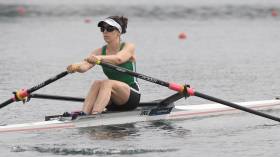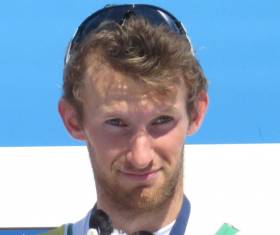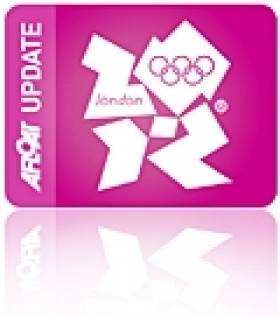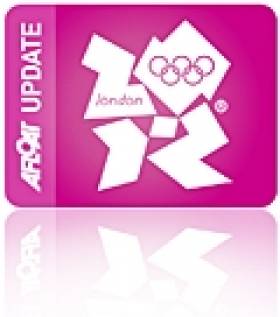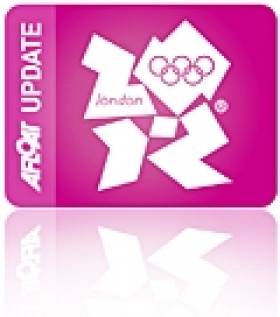Displaying items by tag: Florida
Irish Clubs Contingent Celebrate Success at RS Aero US Midwinters
Dublin Bay Frostbites regulars Roy Van Maanen (Greystones SC) and Noel Butler (National YC) both finished second in their respective fleets at the RS Aero US Midwinters in Florida last weekend.
Varied conditions tested sailors in all wind strengths in very pleasant Florida temperatures across the race week held at Davis Island Yacht Club in Tampa.
Butler had a consistent performance in the shifty breeze on day two in the 7 fleet, scoring 3,2,3 to secure his podium, while Van Maanen enjoyed a game battle with Philip Myerson of Cedar Point YC in Connecticut for first in the 5 fleet, with the US sailor coming up trumps this time out.
The Irish contingent also competed in the Florida State Championship, with Butler taking third place and Van Maanen placing a more than respectable sixth.
And in the Round the Bay Long Distance Race on 8 February, Butler narrowly missed out on first place — under 10 seconds on handicap — to make it a trifecta of podium finishes.
 Noel Butler and Roy Van Maanen (right) at dinner with fellow RS Aero sailors during the race week | Credit: Noel Butler
Noel Butler and Roy Van Maanen (right) at dinner with fellow RS Aero sailors during the race week | Credit: Noel Butler
Butler commented on social media: “Delighted to finish 2nd 7 rig in the RS Aero Class North America Midwinter Championships and 3rd in the Florida State Championships
“Thanks to organiser Ryan Schenck and all at the beautiful Davis Island Yacht Club for the hospitality and a great event.
“Thanks to the Cedar Point Yacht Club RS Aero sailors for providing charter boats and driving them all the way from CT to FL and back!
“Thanks to the Hummingbird Gang (Jeff Dunmall, Madhavan Thirumalai, Boris Mezhibovskiy, Roy Van Maanen) for the epic accomodation, food and fun!”
Both are back in action in Ireland this weekend, with the INSS RS Aero Super Series on Saturday and the DMYC Frostbites on Sunday.
Brilliant Gold Medal for O'Driscoll and O'Donovan at World Rowing
#Rowing: Ireland’s lightweight pair of Mark O’Donovan and Shane O’Driscoll took a brilliant gold medal at the World Rowing Championships in Sarasota-Bradenton in Florida. They got a tough challenge from Italy and Brazil, but O’Donovan and O’Driscoll produced a stunning row, with a stroke rate of well into the 40s right through the race. They took over the lead at 750 metres and never gave it up, despite concerted challenges by, first, Brazil and then Italy, who took second, with the South Americans taking bronze.
Boomer and McQuillan-Tolan Fifth in World Rowing Repechage
#Rowing: The Ireland pair of Fionnán McQuillan-Tolan and Patrick Boomer finished fifth in their repechage today at the World Rowing Championships in Florida. They will compete in the C Final. The top three secured places in the A/B Semi-Finals. Serbia were impressive winners, taking over from Spain in the middle stages. These two held the top spots to the finish. Behind them the United States clung on to third.
Ireland pushed fourth-placed Argentina hard in the third quarter, but it was the South Americans who finished best – they came close to ousting the United States and taking the crucial third spot. The host country held on by just .35 of a second.
World Rowing Championships, Sarasota-Bradenton, Florida – Day Three (Irish interest):
Men
Pair – Repechage (First Three to A/B Semi-Final; rest to C Final): 1 Serbia 6:38.05, 2 Spain 6:40.24, 3 United States 6:41.46; 5 Ireland (F McQuillan-Tolan, P Boomer) 6:47.01.
Walsh Continues Ireland's Winning Run in World Rowing Heats
#Rowing: Denise Walsh made it three wins out of three starts for Ireland at the World Rowing Championships in Florida today. The Ireland lightweight single sculler charged to the line to beat Kirsten McCann of South Africa in an exciting finish to their heat.
Earlier Paul O’Donovan, in the lightweight single and the lightweight pair of Shane O’Driscoll and Mark O’Donovan had also won.
World Rowing Championships, Sarasota-Bradenton, Florida – Day One – Irish Interest:
Men
Lightweight Pair – Heat One (First to A Final; rest to Repechage): 1 Ireland (M O’Donovan, S O’Driscoll) 6:33.20, 2 Britain (J Cassells, S Scrimgeour) 6:38.57, 3 Italy 6:40.39.
Lightweight Single Sculls – Heat Three (First Four to Quarter-Finals; rest to Repechages): 1 Ireland (P O’Donovan) 6:54.68, 2 Brazil 7:05.75, 3 Italy 7:09.88, 4 Thailand 7:17.50.
Women
Lightweight Single Sculls – Heat Three (First Three to A/B Semi-Finals; rest to Repechages): 1 Ireland (D Walsh) 7:43.87, 2 South Africa 7:44.38, 3 Italy 8:03.34.
Gary O'Donovan Out of World Championships
#Rowing: The Ireland team for the World Rowing Championships has been weakened by the non-availability of Gary O’Donovan through illness. The Skibbereen man formed the lightweight double with his brother Paul which took silver at the Olympic Games in 2016. Their 2017 campaign brought them silver at the European Championships and silver and bronze in World Cup regattas. Paul O’Donovan will now defend his World Championship title in the lightweight single sculls at this year’s regatta, which begins on September 24th in Sarasota-Bradenton in Florida.
Gary O’Donovan will travel to the Championships as a spare.
Ireland Team for World Rowing Championships, Sarasota-Bradenton, Florida, September 24th-October 1st:
Men
Pair: F McQuillan-Tolan, P Boomer. Lightweight Pair: M O’Donovan, S O’Driscoll. Lightweight Single Sculls: P O’Donovan
Women
Pair: A Crowley, A Keogh. Single Sculls: S Puspure. Lightweight Single Sculls: D Walsh.
World Rowing Championship Organisers Say Irma Damage 'Limited'
#Rowing: Hurricane Irma’s impact on Florida left a lot of those interested in the World Rowing Championships, which are set to take place in Sarasota from September 24th to October 1st, worried. Immediately after the storm, this was a statement from the local organisers:
“The organizing committee of the 2017 World Rowing Championships has started a complete assessment of the impact of Hurricane Irma. The OC is in constant communication with local and state officials to coordinate the recovery initiatives in the area as well as with the airports, hotels, transport partners and vendors.
“The Sarasota/Bradenton area did not come under the direct impact of the hurricane as predicted thus, luckily, damage is limited. The area is still under movement restrictions until all services are restored and roadway damage is cleared.
“The 2017 World Rowing Championships staff is working diligently along with the support of FISA and USRowing to ensure a safe and successful World Championships.
Further updates will follow in the next 24 to 48 hours.”
Irish Paralympic Team Making a Splash at IFDS Worlds
#PARALYMPICS - Irish team members John Twomey, Anthony Hegarty and Ian Costello are making waves at the World Championships for disabled sailors in Florida this week.
Inside World Parasport reports that the trio from Kinsale Yacht Club are tied for the top spot in the Sonar class, ahead of Norway and France, in the International Association for Disabled Sailing (IFDS) event at Laishey Park Marina.
As previously reported on Afloat.ie, Twomey and his crew have already qualified for the London Paralympics this summer after claiming one of the few rwmaining spots at the IFDS Worlds in Weymouth last July.
Egan Sets Sights on Olympic Canoeing Spot
#CANOEING - The Evening Herald reports that top Irish canoeist Jenny Egan is headed to Florida for a few months of training towards a spot at the 2012 Olympics.
A sprint and marathon racer, Egan was named as The Irish Times/Irish Sport Council's Sportswoman of the Month for May 2010 in recognition of some very impressive performances.
Indeed, the Kildare native enjoyed much success in 2012, with second place in the 5000m at the World Sprint Cup in the Czech Republic and a new Irish record in the 500m at the Canoe Slalom Worlds in Hungary among her achievements.
Heading into 2012, the Salmon Leap club member will surely be shrugging off setbacks like her crash in the heat and humidity of Singapore at the Canoe Marathon Worlds last October.
The new year brings a new focus, as Egan will concentrate on the 500m and 200m K1 sprint distances for the London games, with the final qualifiers - for just 15 spots - taking place in Poland in April.
The Evening Herald has more on the story HERE.
Irish Olympic Crews in Top Twenty of World Rankings
Peter O'Leary who has been sailing with three different crews, David Burrows, Frithjof Kleen and Timothy Goodbody to date is ranked 17th by the International Sailing Federation (ISAF).
O'Leary and Burrows sailing in the Star keelboat class were recent top finishers at 93-boat fleet in Miami. They finished second overall after they lost the overall lead in the last race of the 2011 Bacardi Cup.
Listen into a podcast about Peter O'Leary's Olympic sailing plans HERE.
Fellow Olympic squad member, 21-year old Annalise Murphy from Dun Laoghaire is now ranked 12th in the Laser radial class counting seven ISAF events. Murphy has also had success in Florida this season, she finished fourth in the Miami Olympic Classes regatta in January.
Listen to what Team Manager James O'Callaghan has to say about her progress:
The next release of the ISAF World Sailing Rankings will be on 13 April 2011 and will include the Trofeo SAR Princess Sofia Mapfre in Spain.
The ISAF World Sailing Rankings rate skippers based on their performances over the last two years. Skippers score points by competing in ISAF Graded events. The top finishers at all ISAF Graded events score Rankings points, with the highest points awarded to the event winner and then decreasing down relative to position.
More Irish Olympic Sailing News HERE.
Murphy Stays in Top Five
Annalise Murphy stays in the top five of the Laser Radial fleet after another solid performance at the Miami Olympic Classes Regatta in Florida today. The Dun Laoghaire sailor has slipped one place overall from third to fourth but she will be more than happy to count a fifth from today's race sailed in 15 knots that lightened up towards the finish.
Murphy's rival for London selection 2012, Tiffany Brien from Belfast Lough, lies 26th. The Laser Radial results are HERE.
Annalise training in Fremantle
Meanwhile the Star duo of Peter O'Leary and David Burrows recovered after a DSQ on Tuesday and are back to 15th overall, some 20 points adrift of the top ten in the 56-boat fleet. Star results HERE.
Things started out slowl at US SAILING's Rolex Miami OCR when all but one class was postponed ashore due to light wind that followed morning showers, but the entire fleet of 716 Olympic and Paralympic hopefuls from 53 nations were back in action on Biscayne Bay by afternoon, with sunshine and fresh breezes to improve their day. This is the second stop on the International Sailing Federation (ISAF) Sailing World Cup circuit and is considered a major stepping stone on a sailor's path to securing a berth at the Olympic and Paralympic Sailing Regattas scheduled for Weymouth, England in 2012.
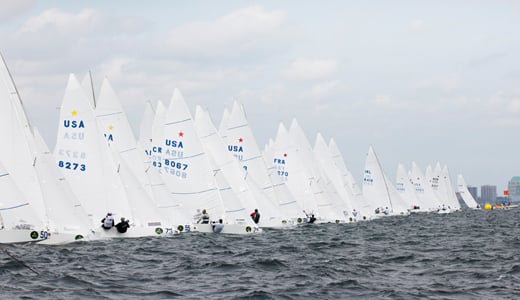
Ireland's O'Leary and Burrows start mid line in race two. Photo: Daniel Forster
After two days of maintaining a lead in the 41-boat Men's 470 class, Nic Asher/Elliot Willis (GBR) were edged out today (day three) by fellow national teammates Luke Patience/Stuart Bithell for the top spot on the scoreboard. Patience/Bithell won today's single race while Asher/Willis took a sixth, using it as a discard race. (After six races, teams are allowed to drop their worst score.) They are now three points behind the new leaders.
"It was a tricky day," said Asher, who with Willis has won the Men's 470 Worlds twice. The wind was off the land so it was shifty and gusty, lots of places changed, but our sixth was solid. Tomorrow it's all to play for."
Patience said his team's victory today came after a disappointing start. "We didn't pop out in front until about two-thirds up the second windward leg; that's pretty late in the race, but as it developed, the lanes opened up. There was not much pattern to the wind, which went from 10 knots up to 15 knots, so it was an active kind of sailing-- a lot of dividing our time between looking around and driving."
Leaders from day one in the 24-boat Women's 470 class, Ingrid Petijean/ Nadege Douroux (FRA), had a "disappointing" race—a 12th—but still hang on for a one-point lead over Penny Clark (GBR), who won today's race to move to second
"Before the start, you could see the dark clouds approaching," said US Sailing Team AlphaGraphics 470 coach Mark Ivey (San Francisco, Calif.), and the teams were scrambling to adjust their rig settings for high wind, but as the race went on, the squall line passed, more toward the Star course (farther out), and it lightened into a leftover westerly breeze."
The 470s are in for a long day tomorrow, as it is anticipated they will sail three races to catch up with their two-races-a-day schedule before the final medal races (for top-ten in each of the ten Olympic classes) conclude the regatta on Sunday.
With two races today in the 56-boat Star class, Robert Scheidt/Bruno Prada (BRA) still shine. They finished 9-7 while Fredrik Loof/Max Salminen (SWE) posted a 15-5. Only two points separate them from the leaders and the third-place finishers Xavier Rohart and Pierre Alexis Ponsot (FRA).
Yet another GBR team leads the 49ers, and they have done so since yesterday in the 29-boat fleet. John Pink/ Rick Peacock finished 4-6-1 today and used the sixth as a permitted discard in their final score, which is 18 points to the 19 carried by Dave Evans/Edward Powys, also from the UK.
The 49er, a skiff that flies across the water with its skipper and crew hanging out over the water on "trapezes," is considered the Ferrari of sailboat racing and can reach blazing speeds. The class started in 1995 and parachuted into the Olympic Games in 2000. The fleet has grown substantially over the last decade, attracting sailors from other classes who seek fast and exhilarating racing. Their races are only 30 minutes long, so they can squeeze in up to four races a day in perfect conditions
"It's going well – we've had some great races really and a mixed bag with conditions," said Pink, noting a total of five victories in his team's nine-race score line. "Yesterday was very boat speed oriented and we managed to crack that quite well and today was a lot more shifty so it was more about minimizing risk. The results could have been a lot worse today, so we battled through and we've been enjoying it." Pink and Peacock won a silver medal here at the 2009 Rolex Miami OCR.
"You get a little confidence boost," said Pink about being lucky enough to do well here among so many of the world's leading sailors, "and aside from that it's just a nice place to be with good weather and good training conditions."
For fleet racing in the Olympic classes, the regatta consists of a five-day opening series (Monday – Friday) and a double-point medal race (Saturday). The top 10 finishers in the opening series of each class will advance to the medal race. For match racing (Elliot 6m), which makes its debut in the 2012 Olympic Games, the regatta consists of an opening series, a knockout series, and a sail-off for boats not advancing to the knockout series. Competitors in the Paralympic classes will have five days of fleet racing (Monday-Friday) and no medal race. Medals will be awarded to the top three boats in each Olympic and Paralympic class on Saturday, January 29.
US SAILING has partnered with the city of Miami to provide world-class venues for competition. Additional hosts for the event include Coral Reef Yacht Club, Key Biscayne Yacht Club, Coconut Grove Sailing Club, Miami Rowing Club and Shake-a-Leg Miami. These sailing organizations host classes onshore, as well as help run the on-the-water racing. The Coral Reef Yacht Club also hosts the Opening and Closing Ceremonies.
In addition to title sponsor Rolex Watch U.S.A., US SAILING's 2011 Rolex Miami OCR is also sponsored by AlphaGraphics, Gowrie Group, Chubb Insurance, Sperry Top-Sider, Harken McLube, Trinity Yachts, University of Miami Hospital and Kattack.
A complete roster of competitors can be viewed at the event website, RMOCR.ussailing.org, where real-time racecourse blogging, commentary and fan interaction, regatta results, photos and news updates will be integrated into a live coverage platform once racing begins. Video highlights produced by Gary Jobson and presented by Rolex air daily and are available on-demand on the event website. Fans can also follow the event on Facebook/RMOCR and Twitter/RMOCR.
US SAILING's 2011 Rolex Miami OCR
Top-three Finishes
Day 3
49er (29 boats) – 9 races
1. John Pink/ Rick Peacock (GBR) 4- 1- 5-1-1-1-4-[6]-1 (18)
2. Dave Evans/Edward Powys (GBR) 2- [6]-1-3-3-2-5-1-2 (19)
3. Paul Brotherton/Mark Asquith (GBR) 1-3-2-5-2-[10]-2-10-5 (30)
Laser Radial (58 boats) – 6 races
1. Marit Bouwmeester (NED) [4]-1-3-3-4-1 (12)
2. Evi Van Acker (BEL) 2-2-1-1-7-[16] (13)
3. Paige Railey (USA) 1-[59/BFD]-4-6-2-5 (18)
Laser (104 boats)-6 races
1. Rasmus Myrgren (SWE) [7]-3-1-1-1-3 (9)
2. Paul Goodison (GBR) 1-2-8-1-[53/DSQ]-1(13)
3. Nick Thompson (GBR) [7]-4-1-2-2-5 (14)
Finn (37 boats) – 5 races
1. Giles Scott (GBR) 1-1-1-1-[38/OCS] (4)
2. Brendan Casey (AUS) 3-4-3-[7]-1 (11)
3. Zach Railey (USA) 2-3-4-[6]-4 (13)
470 Men (42 boats) – 5 races
1. Luke Patience/Stuart Bithell (GBR) 3-2-2-[5]-1(8)
2. Nic Asher/Elliot Willis (GBR) 1-3-5-2-[6] (11)
3. Mathew Belcher/ Malcolm Page (AUS) 2-8-[10]-3-3(16)
470 Women (24 boats) – 5 races
1. Ingrid Petijean/ Nadege Douroux (FRA) 1-2 3-4-[12] (10)
2. Penny Clark/ Katrina Hughes (GBR) 4-4-2-[6]-1 (11)
3. Camille Lecointre/Mathilde Geron (FRA) 3-1-1-8-[25/BFD] (13)
Skud-18 (7 boats) – 5 races
1. Daniel Fitzgibbon/Liesl Tesch (AUS) 1-1-4-1-[8/OCS] (7)
2. Jennifer French/ Jean-Paul Creignou (USA) [3]-3-1-2-2 (8)
3. Alexandra Rickham/Niki Birrell (GBR) 2-4-3-[5]-1 (10)
Star (57 boats) – 6 races
1. Robert Scheidt/Bruno Prada (BRA) 1-2-[9]-1-9-7 (20)
2. Fredrik Loof/Max Salminen (SWE) 5-3-7-3-[15]-6 (24)
3. Xavier Rohart/Pierre Alexis Ponsot (FRA) [7]-7-1-6-7-5 (26)
RS: X Men (37 boats) – 6 races
1. Dorian van Rijsselberge (NED) 1-[4]-1-1-2-4 (9)
2. Nick Dempsey (GBR) 2-2-[4]-4-3-1 (12)
3. Nimrod Mashiah (ISR) 7-3-2-2-1-[11] (15)
RS: X Women (30 boats) – 6 races
1. Marina Alabau (ESP) [1]-1-1-1-1-1 (5)
2. Bryony Shaw (GBR) [7]-2-2-2-2-6 (14)
3. Charline Picon (FRA) 2-6-3-5-[9]-2 (18)
2.4mR (30 boats) – 4 races (No Races Sailed Today)
1. Damien Seguin (FRA) 2-5-1-1 (9)
2. Allan Leibel (CAN) 3-2-2-2 (9)
3. Thierry Schmitter (NED) 1-1-4-4 (10)
Sonar (12 boats) – 5 races
1. John Roberston/ Hannah Stodel/ Steve Thomas (GBR) 3-2-1-[7]-2 (8)
2. Albert Foster/David Burdette/Mike Hersey (USA) 1-[12]-5-1-5 (12)
3. Udo Hessels/ Mischa Rossen/Marcel van de Veen (NED) 2-1-4-[13/DNS]-6 (13)
Elliott 6m -- Gold Round Robin Results
Lucy Macgregor/Mary Rook/ Kate Macgregor (GBR); 2-1
Claire Leroy/ Elodie Bertrand/Marie Riou (FRA); 2-1
Anna Tunnicliffe(/Molly Vandemoer/Debbie Capozzi (Plantation, Fla., USA/Redwood City, Calif., USA/(Bayport, N.Y., USA);2-1
Ekaterina Skudina/Elena Syuzeva/Irina Lotsmanova (RUS); 2-1
Silja Lehtinen/Silja Kanerva/Mikaela Wulff (FIN); 1-2
Nicky Souter/Jessica Eastwell/Olivia Price (AUS); 0-3
Repechage Round Robin Results
Stephanie Hazard/ Susannah Pyatt/ Jenna Hansen (NZL); 3-0
Julie Bossard/Pauline Chalaux/ Nolwenn Combeaux (FRA); 2-1
Sally Barkow (Nashotah, WI., USA)/ Alana O'Reilly (Charleston SC, USA)/ Elizabeth Kratzig-Burnham (Miami Beach FL, USA); 2-1
Renee Groeneveld/Mandy Mulder/Merel Witteveen(NED);1-2
Lotte Meldgaard Pedersen/Christina Refn/Susanne Boidin (DEN); 1-2
Rita Goncalves/Mariana Lobato/Diana Neves (POR); 0-3
Silver Round Robin Results- No Races Sailed
Silke Hahlbrock/ Kerstin Schult / Maren Hahlbrock (GER)
Genny Tulloch/Alice Leanoard/Jennifer Chamberlin (Sausalito, CA.,USA/East Haven, CT., USA/Washington, DC., USA)
Anne-Claire Le Berre/ Alice Ponsar/ Myrtille Ponge (FRA)
Anna Kjellberg/ Malin Kallstrom/ Lotta Harrysson (SWE);
Renata Decnop/Fernanda Decnop/Tatiana Ribeiro (BRA);
Katie Spithill/Nina Curtis/Angela Farrell (AUS);
Bronze Round Robin Results
Vesna Dekleva Paoli/ Katarina Kersevan/ Lena Koter (SLO); 2-0
Annemiek Bekkering/ Brechtje van der Werf/ Annemiek Bes(NED); 1-1
Rebecca Dellenbaugh (Easton CT, USA)/ Maggie Shea (Wilmette, IL USA)/ Janel Zarkowsky (Annapolis, MD USA); 1-1
Jinny Gordon/Crystle Numan/ Laurel Gordon-Taylor (CAN); 0-2
Juliana Senfft/Gabriela Sa/Daniela Adler (BRA); 1-1
Katie Abbott/ Joanne Prokop/ Caroline Kaars Sijpesteijn (CAN); 1-1




























